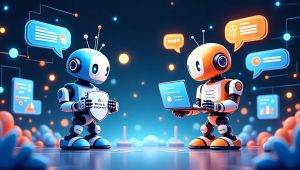AI ML Roadmap: Your Guide to Mastering AI and Machine Learning
Artificial Intelligence (AI) and Machine Learning (ML) are transforming industries worldwide. From healthcare to finance, these technologies are driving innovation. But how do you start your journey in AI and ML? This article provides a clear AI ML roadmap to help you navigate this exciting field. We’ll cover key steps, tools, and resources to help you succeed.

What is AI and ML?
AI refers to machines that can perform tasks requiring human intelligence. ML is a subset of AI. It focuses on algorithms that learn from data. Together, they power technologies like self-driving cars, chatbots, and recommendation systems.
Why Follow an AI ML Roadmap?
The field of AI and ML is vast. Without a clear plan, it’s easy to get lost. A well-structured AI ML roadmap helps you:
- Build a strong foundation.
- Stay focused on your goals.
- Avoid wasting time on irrelevant topics.
Step 1: Understand the Basics
Before diving into AI and ML, you need a solid understanding of the basics.
Learn Programming
Python is the most popular language for AI and ML. It’s easy to learn and has many libraries. Start with Python basics like variables, loops, and functions.
Study Mathematics
Math is the backbone of AI and ML. Focus on:
- Linear Algebra: Used in data manipulation.
- Calculus: Helps in optimizing algorithms.
- Probability and Statistics: Essential for data analysis.
Explore Data Science
Data is the fuel for AI and ML. Learn how to collect, clean, and analyze data. Tools like Pandas and NumPy are great for data manipulation.

Step 2: Dive into Machine Learning
Once you have the basics, it’s time to explore ML.
Understand ML Concepts
Learn about supervised, unsupervised, and reinforcement learning. Understand key algorithms like linear regression, decision trees, and neural networks.
Practice with Real-World Projects
Apply your knowledge by working on projects. Start with simple datasets. Use platforms like Kaggle to find datasets and competitions.
Use ML Libraries
Libraries like Scikit-learn and TensorFlow make ML easier. They provide pre-built functions for common tasks.
Step 3: Explore Advanced Topics
After mastering the basics, move on to advanced topics.
Deep Learning
Deep learning is a subset of ML. It uses neural networks to solve complex problems. Learn about frameworks like Keras and PyTorch.
Natural Language Processing (NLP)
NLP helps machines understand human language. It’s used in chatbots, translation, and sentiment analysis.
Computer Vision
This field focuses on teaching machines to interpret images. Applications include facial recognition and autonomous vehicles.
Step 4: Build a Portfolio
A strong portfolio showcases your skills. Include projects that demonstrate your expertise in AI and ML.
Choose Diverse Projects
Work on projects from different domains. For example, build a recommendation system, a fraud detection model, and an image classifier.
Share Your Work
Use platforms like GitHub to share your code. Write blogs or create videos to explain your projects.

Step 5: Stay Updated
AI and ML are fast-evolving fields. Stay updated with the latest trends and technologies.
Follow Industry Leaders
Read blogs, watch videos, and attend webinars by experts. Follow organizations like OpenAI and DeepMind.
Join Communities
Join online forums and social media groups. Engage in discussions and ask questions.
Take Advanced Courses
Enroll in advanced courses to deepen your knowledge. Platforms like Coursera, edX, and Udacity offer great options.

Tools and Resources for Your AI ML Roadmap
Here are some tools and resources to help you on your journey:
Programming
- Python: The go-to language for AI and ML.
- Jupyter Notebook: A great tool for writing and sharing code.
Mathematics
- Khan Academy: Free courses on math topics.
- 3Blue1Brown: YouTube channel with visual math explanations.
Data Science
- Pandas: Library for data manipulation.
- NumPy: Library for numerical computations.
Machine Learning
- Scikit-learn: Library for ML algorithms.
- TensorFlow: Framework for building neural networks.
Deep Learning
- Keras: High-level neural networks API.
- PyTorch: Popular framework for deep learning.
NLP
- NLTK: Library for NLP tasks.
- SpaCy: Industrial-strength NLP library.
Computer Vision
- OpenCV: Library for computer vision tasks.
- YOLO: Algorithm for real-time object detection.
Common Mistakes to Avoid
Here are some common mistakes beginners make:
Skipping the Basics
Don’t rush into advanced topics without understanding the basics.
Ignoring Math
Math is essential for understanding algorithms. Don’t skip it.
Not Practicing Enough
Theory is important, but practice is key. Work on real-world projects.
Not Staying Updated
AI and ML are constantly evolving. Stay updated with the latest trends.

Career Opportunities in AI and ML
AI and ML offer exciting career opportunities. Here are some roles you can pursue:
Data Scientist
Data scientists analyze and interpret complex data. They use ML algorithms to find insights.
Machine Learning Engineer
ML engineers build and deploy ML models. They work on optimizing algorithms for performance.
AI Researcher
AI researchers focus on developing new algorithms and techniques. They work on cutting-edge technologies.
NLP Engineer
NLP engineers work on language-related applications. They build chatbots, translation systems, and more.
Computer Vision Engineer
These engineers work on image and video analysis. They develop systems for facial recognition, object detection, and more.
Conclusion
The AI ML roadmap is your guide to mastering artificial intelligence and machine learning. Start with the basics, dive into ML, explore advanced topics, and build a strong portfolio. Stay updated with the latest trends and tools. With dedication and practice, you can succeed in this exciting field.
Remember, the journey may be challenging, but the rewards are worth it. Follow this roadmap, and you’ll be well on your way to becoming an AI and ML expert.
Share this content:
















Post Comment